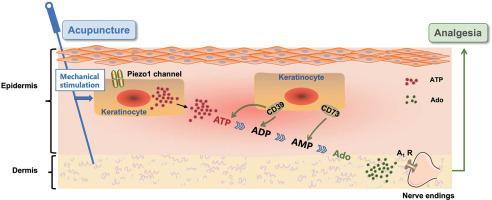角化细胞Piezo1和CD39通过协同调节穴位细胞外ATP动员启动针刺镇痛信号
IF 3
3区 医学
Q1 INTEGRATIVE & COMPLEMENTARY MEDICINE
Journal of Traditional and Complementary Medicine
Pub Date : 2025-10-01
DOI:10.1016/j.jtcme.2024.09.006
引用次数: 0
摘要
穴位是针刺镇痛信号的起始点,腺苷信号在其中起着至关重要的作用。全面了解这一问题将指导临床医生优化针灸手法,提高针灸疗效。近年来,角质细胞Piezo1通道和级联ATP释放被独立地揭示为皮肤触觉的必要条件。因此,我们的目的是研究角化细胞piezo1介导的ATP释放是否与CD39协同作用,通过产生腺苷促进了这种启动机制。急性踝关节关节炎大鼠单侧ST36穴针刺20 min。确定受影响后爪的疼痛阈值。微透析法提取间质ATP和腺苷,荧光素-荧光素法和高效液相色谱法测定。为了模拟针刺刺激,角化细胞HaCaT受到低渗休克。ATP释放和活钙成像。免疫荧光标记显示在角质形成细胞上存在Piezo1和CD39。针刺可引起迅速的镇痛作用,并使ATP和腺苷暂时积累。激活腺苷A1受体,通过激活Piezo1促进ATP释放,或通过增强CD39促进ATP水解实现抗伤害作用。相反,在相反的方向改变这些调节会逆转针灸的后续效果。针刺诱导的间质ATP积累与这些调节平行变化。低渗休克导致HaCaT中ATP释放和[Ca2+]i升高,这些过程被siRNA-Piezo1的引入所阻碍,或通过Piezo1的激动作用被复制。这些发现表明,角化细胞Piezo1和CD39共同介导ATP在穴位的动员,通过触发腺苷信号,有助于针灸镇痛的启动信号。物理/心理实践(针灸)分类(根据视觉分类)疼痛和镇痛。本文章由计算机程序翻译,如有差异,请以英文原文为准。

Keratinocyte Piezo1 and CD39 initiated the acupuncture analgesic signals via Co-regulating extracellular ATP mobilization at acupoints
Acupoints are the initiation sites for acupuncture analgesic signals, where adenosine signaling plays a crucial role. A comprehensive understanding of this matter will guide clinicians to optimize acupuncture manipulations to improve acupuncture effectiveness. Recently, keratinocyte Piezo1 channels and cascade ATP release are independently unveiled to be essential for the skin tactile sensation. Thus, we aimed to investigate whether keratinocyte Piezo1-mediated ATP release, in orchestration with CD39, contributed to this initiation mechanism via producing adenosine. 20-min needling was administered at the unilateral ST36 acupoint on the acute ankle arthritis rats. The pain thresholds in the affected hindpaws were determined. Interstitial ATP and adenosine were extracted with microdialysis and assessed by luciferase-luciferin and HPLC, respectively. To simulate needling stimulation, keratinocyte HaCaT cells were subjected to hypotonic shock. ATP release and live calcium imaging were conducted. Immunofluorescence labeling showed the presence of Piezo1 and CD39 on keratinocytes. Acupuncture led to a prompt analgesic effect, as well as a temporary accumulation of ATP and adenosine. Activating adenosine A1 receptors, promoting ATP release by activating Piezo1, or facilitating ATP hydrolysis by potentiating CD39 achieved anti-nociceptive effects. Conversely, altering these modulations in the opposite direction reversed the subsequent effects of acupuncture. Needling-induced accumulation of interstitial ATP parallelly changed with these modulations. Hypotonic shock led to ATP release and [Ca2+]i rise in HaCaT, which were impeded by introducing siRNA-Piezo1, or replicated by agonism at Piezo1. These findings suggest that keratinocyte Piezo1 and CD39 co-mediated ATP mobilization at acupoints contributes to the initiation signals of acupuncture analgesia via triggering adenosine signaling.
Section
Physical/Mental practices (acupuncture)
Taxonomy (classification by evise)
pain and analgesia.
求助全文
通过发布文献求助,成功后即可免费获取论文全文。
去求助
来源期刊

Journal of Traditional and Complementary Medicine
Medicine-Complementary and Alternative Medicine
CiteScore
9.30
自引率
6.70%
发文量
78
审稿时长
66 days
期刊介绍:
eJTCM is committed to publish research providing the biological and clinical grounds for using Traditional and Complementary Medical treatments as well as studies that demonstrate the pathophysiological and molecular/biochemical bases supporting the effectiveness of such treatments. Review articles are by invitation only.
eJTCM is receiving an increasing amount of submission, and we need to adopt more stringent criteria to select the articles that can be considered for peer review. Note that eJTCM is striving to increase the quality and medical relevance of the publications.
 求助内容:
求助内容: 应助结果提醒方式:
应助结果提醒方式:


